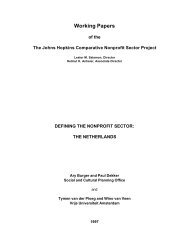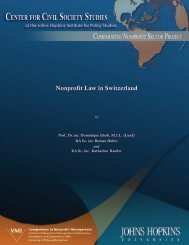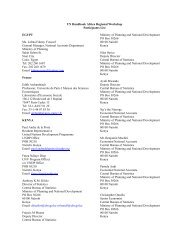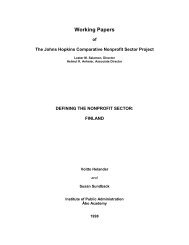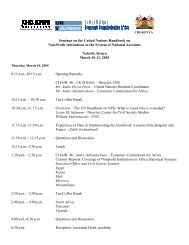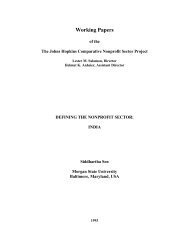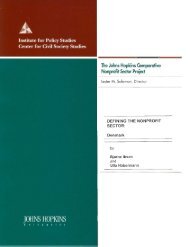Defining the Nonprofit Sector: Argentina
Defining the Nonprofit Sector: Argentina
Defining the Nonprofit Sector: Argentina
Create successful ePaper yourself
Turn your PDF publications into a flip-book with our unique Google optimized e-Paper software.
Campetella, González Bombal, and Roitter<strong>Defining</strong> <strong>the</strong> <strong>Nonprofit</strong> <strong>Sector</strong>: <strong>Argentina</strong>organizations, <strong>the</strong> Hermandad de la Santa Caridad (Holy Charity Bro<strong>the</strong>rhood), fulfilled asignificant function, managing a hospital for women (Hospital de Mujeres), an orphanage for girls(Casa de Huérfanas), and ano<strong>the</strong>r one for boys (Casa de Niños Expósitos).Independence PeriodAt <strong>the</strong> beginning of <strong>the</strong> 19 th century, after independence from <strong>the</strong> Spanish Crown, two maintransformations brought about changes in <strong>the</strong> situation of voluntary organizations. On <strong>the</strong> one hand,<strong>the</strong>re was a long period of political anarchy and internal struggles that lasted until 1880. During thisperiod <strong>the</strong>re was nei<strong>the</strong>r a central state nor a central authority, but only different alliances among <strong>the</strong>provinces, within which <strong>the</strong> province of Buenos Aires played a dominant role. On <strong>the</strong> o<strong>the</strong>r hand,<strong>the</strong>re was a wave of secularization to limit <strong>the</strong> power and attributions of <strong>the</strong> Catholic Church.Among o<strong>the</strong>r things, <strong>the</strong> charity institutions –e.g., hospitals, orphanages– were wrested from <strong>the</strong>Church’s control, and some of <strong>the</strong> main organizations related to <strong>the</strong> Church, such as <strong>the</strong> Hermandadde la Santa Caridad, were dissolved.However, as mentioned, <strong>the</strong>se secular reforms were performed during a period of politicalanarchy and absence of a central government. Consequently, <strong>the</strong>y were not accompanied by <strong>the</strong>constitution and consolidation of a secular power that, among o<strong>the</strong>r things, could have administered<strong>the</strong> charity institutions that until that moment were managed by <strong>the</strong> Catholic Church or byinstitutions related to it. Given this situation, in 1823 <strong>the</strong> Minister of Government of <strong>the</strong> Province ofBuenos Aires convoked a group of high society ladies in order to create an association –<strong>the</strong> Sociedadde Beneficencia (Society of Beneficence)– in charge of administering <strong>the</strong> charity institutions. Eventhough <strong>the</strong> Sociedad de Beneficencia was created as an administrative organ subordinated to <strong>the</strong>public power, from <strong>the</strong> very beginning it showed great autonomy, made its own decisions, anddeveloped its own strategies in order to raise funds. The creation of <strong>the</strong> Sociedad de Beneficenciacan be thought as a landmark in <strong>the</strong> history of <strong>the</strong> Argentine nonprofit sector. Not only did <strong>the</strong>society carry out essential work in <strong>the</strong> health and welfare areas until its dissolution in 1946, but alsoit maintained an ambiguous position between <strong>the</strong> public and <strong>the</strong> private spheres constituting a clearexample of <strong>the</strong> fluid borders between <strong>the</strong> state and <strong>the</strong> third sector.Consolidation of <strong>the</strong> State and Emergence of Civil SocietyBy 1880 <strong>the</strong> period of political anarchy and internal struggles had ended, a central state wasconsolidated, and a national market was organized according to an economic model that privileged<strong>the</strong> exportation of primary goods. In spite of <strong>the</strong>se transformations, several features of <strong>the</strong> colonialsociety persisted: <strong>the</strong> centralization of <strong>the</strong> state, <strong>the</strong> strong presence of traditional elites who were <strong>the</strong>main beneficiaries of <strong>the</strong> economic model, and <strong>the</strong> strong presence of <strong>the</strong> Catholic Church. Theconcept of patrimonial state (Weber, 1994; Portantiero, 1992) seems to be <strong>the</strong> most appropriate toapply to this period. The concept refers to a social system in which <strong>the</strong> borders between <strong>the</strong> publicand <strong>the</strong> private spheres are blurred, owing to <strong>the</strong> prevalence of <strong>the</strong> traditional elites’ personal criteriain <strong>the</strong> organization of political power.However, as mentioned before, this political organization mounted on traditional structureswas combined with <strong>the</strong> economic insertion of <strong>Argentina</strong> in <strong>the</strong> international market. <strong>Argentina</strong>’s3



